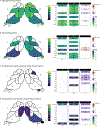Normative Modeling of Thalamic Nuclear Volumes and Characterization of Lateralized Volume Alterations in Alzheimer's Disease Versus Schizophrenia
- PMID: 39182722
- PMCID: PMC11895802
- DOI: 10.1016/j.bpsc.2024.08.006
Normative Modeling of Thalamic Nuclear Volumes and Characterization of Lateralized Volume Alterations in Alzheimer's Disease Versus Schizophrenia
Abstract
Background: Thalamic nuclei facilitate a wide range of complex behaviors, emotions, and cognition and have been implicated in neuropsychiatric disorders including Alzheimer's disease (AD) and schizophrenia (SCZ). The aim of this work was to establish novel normative models of thalamic nuclear volumes and their laterality indices and investigate their changes in SCZ and AD.
Methods: Volumes of bilateral whole thalami and 10 thalamic nuclei were generated from T1 magnetic resonance imaging data using a state-of-the-art novel segmentation method in healthy control participants (n = 2374) and participants with early mild cognitive impairment (n = 211), late mild cognitive impairment (n = 113), AD (n = 88), and SCZ (n = 168). Normative models for each nucleus were generated from healthy control participants while controlling for sex, intracranial volume, and site. Extreme z-score deviations (|z| > 1.96) and z-score distributions were compared across phenotypes. z Scores were associated with clinical descriptors.
Results: Increased infranormal and decreased supranormal z scores were observed in SCZ and AD. z Score shifts representing reduced volumes were observed in most nuclei in SCZ and AD, with strong overlap in the bilateral pulvinar, medial dorsal, and centromedian nuclei. Shifts were larger in AD, with evidence of a left-sided preference in early mild cognitive impairment while a predilection for right thalamic nuclei was observed in SCZ. The right medial dorsal nucleus was associated with disorganized thought and daily auditory verbal hallucinations.
Conclusions: In AD, thalamic nuclei are more severely and symmetrically affected, while in SCZ, the right thalamic nuclei are more affected. We highlight the right medial dorsal nucleus, which may mediate multiple symptoms of SCZ and is affected early in the disease course.
Keywords: Medial dorsal nucleus; Normative modeling; Schizophrenia; Thalamic nuclei; Thalamus; Ventral anterior nucleus.
Copyright © 2024 Society of Biological Psychiatry. Published by Elsevier Inc. All rights reserved.
Conflict of interest statement
Conflict of Interest
The authors report no biomedical financial interests or potential conflicts of interest.
Figures







Update of
-
Normative modeling of thalamic nuclear volumes.medRxiv [Preprint]. 2024 Mar 8:2024.03.06.24303871. doi: 10.1101/2024.03.06.24303871. medRxiv. 2024. Update in: Biol Psychiatry Cogn Neurosci Neuroimaging. 2025 Jul;10(7):726-739. doi: 10.1016/j.bpsc.2024.08.006. PMID: 38496426 Free PMC article. Updated. Preprint.
References
MeSH terms
Grants and funding
LinkOut - more resources
Full Text Sources
Medical

